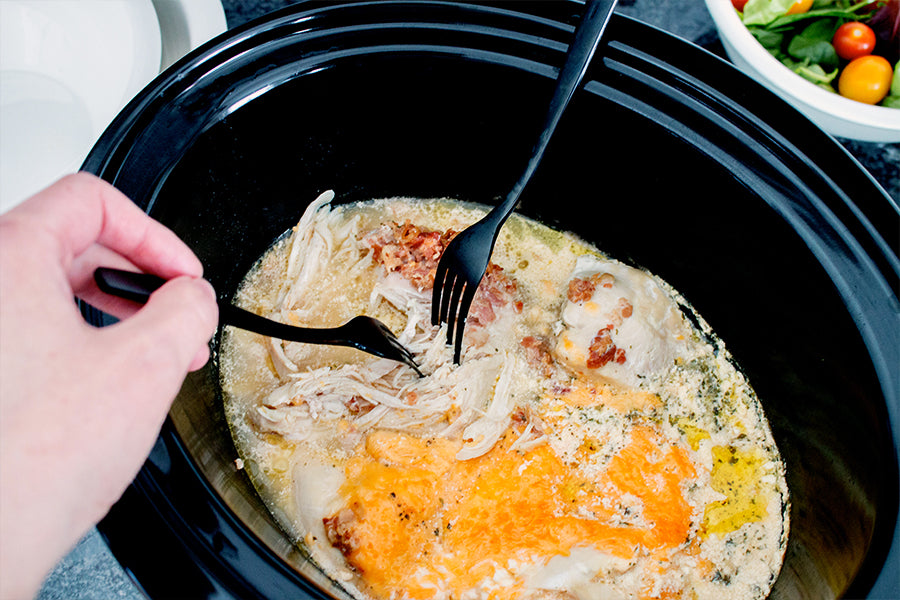How to Thicken Runny Sauces and Soups

When cooking one of our Beehive Meals, it’s helpful to know how the slow cooking process works to help prevent potential issues from occurring and make adjustments. For instance, slow cooker meals can turn out to be watery when there is too much liquid added at the beginning of the preparation or if during the cooking process, the water does not evaporate producing a runny consistency.
In this post, we explore different ways you can use to thicken your sauces or soups if this does end up happening to you.
How Slow Cooking Works
Generally speaking, there are two ways to cook food; dry heat or moist heat. Dry heat being more conventional through baking or grilling while moist heat employs water or water-based cooking liquid through a slow cooker (Crockpot) and pressure cookers (InstantPot).
Though our freezer meals are flexible enough for dry heat, the meals have been primarily designed for slow cookers. This is so that the meats can be easily shredded and mixed with the sauce. Plus the “set it and forgot it” aspect of slow cooking is extremely convenient!
As the slow cooker heat up, the ingredients begin to simmer and release steam. The steam is then trapped by the lid, creating condensation. The condensation creates a vacuum seal between the lid and the pot, then naturally retains the moisture in your food as it cooks. This is the effect that you want to happen when you’ve added the right amount of water.
However, sometimes too much water is accidentally added or the slow cooker fails to evaporate enough water during the cooking process, leaving the sauce or soup a little runnier than you’d like.
What can I do if my sauces and soups do end up too runny?
1) Pre-Cooking Adjustments/ Add Less Water
If you notice a consistent trend with your meals being too runny or soupy, you may want to consider making adjustments before you begin cooking as there is a chance that your slow cooker isn’t the right size or is failing to cook hot enough. Both reasons could lead to failure to evaporate enough water from the meal.
Start by decreasing the amount of water by 25% and experimenting from there. At this point, it will be up to you to identify your personal preference with the sauce or soup’s consistency. As mentioned above, please keep in mind that water is essential during the moist cooking process so be sure not to remove too much.
2) Let the Sauce Cool Down
It is common for moisture and the natural fats/ oils of the ingredients to release during the cooking process causing the sauce to seem runny when you first remove the lid. Once fully cooked, you’ll want to mix everything back together then move the temperature to ‘Keep Warm’ until you’re ready to plate and serve. As the sauce begins to cook down, it will begin to solidify allowing the sauce to thicken.
3) Remove the Lid, Allowing some of the Liquid to Evaporate
By removing the lid during the cooking process, you’re essentially mimicking how a pan or pot without a lid on a stovetop would cook as the liquids escape via steam from the top of the pot.
If you decide to use this method, make sure you watch it closely. Check on it every 10-15 minutes to make sure it doesn’t reduce down too much.
4) Make a Roux and Add It to Your Sauce Mid-Cooking
The preferred way of any professional chef is to thicken the sauce with a roux.
A roux is a mixture of equal parts flour and fat (usually butter) cooked in a pan over low to medium heat. In a cooking pan, cook equal parts unsalted butter and all-purpose flour, stirring constantly with wooden spatula to break up lumps in the flour, until mixture thickens. Then add the roux to your already simmering sauce in the slow cooker.
5) Adding Cornstarch Slurry
A cornstarch slurry is a mixture of a cold liquid with cornstarch. It is used as a thickening agent, and is particularly common in Asian sauces. As a rule of thumb, dissolve 2 parts cold water and 1 part cornstarch. Add the slurry to your sauce as it simmers in the slow cooker.
Cornstarch is always a good way to thicken a sauce or soup but personally I would recommend going a different route as the cornstarch slurry may change the flavor of the meal. But that’s the beauty of our meals as there are multiple ways to prep things your way.
In you have any additional questions regarding adjustments, feel free to reach out to us at hello@beehivemeals.com or 801-589-0591.




